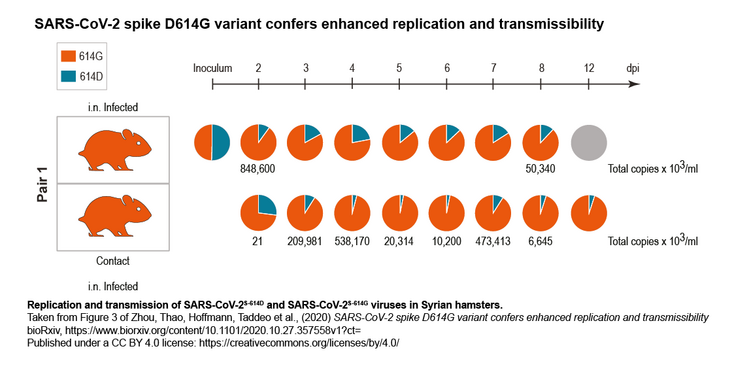In a recent preprint posted on bioRxiv this week, researchers from the NCCR RNA & Disease group of Volker Thiel (University of Bern) together with the groups of Martin Beer (Friedrich-Loeffler-Institute, Germany), David Wentworth (CDC COVID-19 Response, USA) and Charaf Benarafa (University of Bern) describe how a mutation in the spike protein of SARS-CoV-2 confers a fitness advantage over the parental SARS-CoV-2 virus strain and, thus, could explain the predominance of the S-614G SARS-CoV-2 virus strain in the global COVID-19 pandemic.
Abstract
During the evolution of SARS-CoV-2 in humans a D614G substitution in the spike (S) protein emerged and became the predominant circulating variant (S-614G) of the COVID-19 pandemic. However, whether the increasing prevalence of the S-614G variant represents a fitness advantage that improves replication and/or transmission in humans or is merely due to founder effects remains elusive. Here, we generated isogenic SARS-CoV-2 variants and demonstrate that the S-614G variant has (i) enhanced binding to human ACE2, (ii) increased replication in primary human bronchial and nasal airway epithelial cultures as well as in a novel human ACE2 knock-in mouse model, and (iii) markedly increased replication and transmissibility in hamster and ferret models of SARS-CoV-2 infection. Collectively, our data show that while the S-614G substitution results in subtle increases in binding and replication in vitro, it provides a real competitive advantage in vivo, particularly during the transmission bottle neck, providing an explanation for the global predominance of S-614G variant among the SARS-CoV-2 viruses currently circulating.
Download the Preprint from bioRxiv
Figure 3 and abstract from Zhou, Thao, Hoffmann, Taddeo et al., (2020) SARS-CoV-2 spike D614G variant confers enhanced replication and transmissibility posted on bioRxiv. Published under a CC BY-NC-ND 4.0 license.
